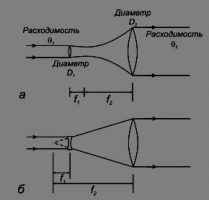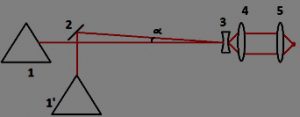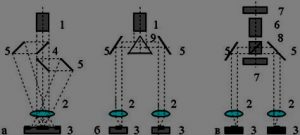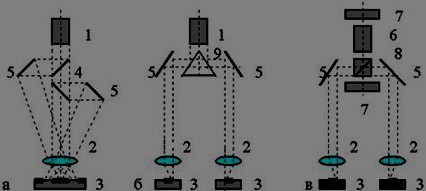Right now we are trying to find the best way to focus a few beams at one spot.
Here are our thoughts and ideas.
Task
The task: to ensure operation with two sources of laser energy for increasing the power density of the resulting laser beam.
Supposed ways of solving the problem:
Laser beams combining by way of using focusing, refracting and reflective elements.
Main theory
Optical systems (OS) serve to apply the laser energy to the place of treatment, to regulate the laser parameters, to form a laser beam with high power density, to visually focus the beam at the action point, to control the process of treatment and to evaluate the end result. Optical systems constructed to transmit and transform powerful operating laser energy are called energy OS. According to their functional features, they may be divided into: a) focusing, b) scanning, c) projecting, d) distributing. The element base of OS consists of focusing, refracting and reflective elements. In the visible light and nearest infra-red range full internal reflection prisms and interference mirrors with multilayer dielectric coatings are used. The use of the latter makes it possible to reduce radiation losses (anti-reflection coatings). In operating at λ = 10.6 μm, mirrors with coatings of Al and Au are used, which have a high reflection coefficient R and are resistant to oxidation.
In energy optical systems using powerful lasers, especially, operating in the continuous wave laser regime, the optic elements are of paramount importance. For the laser radiation with λ = 0.69 and 1.06 μm, most optical glass grades have a small absorption coefficient and are used up to I0 = 103 W / cm2. At a wavelength of l = 10.6 microns, they are opaque, the material for the production of lenses is the single crystals of KBr, NaCl, GaAs, Ge, etc.
Simple estimation of the minimum spot radius rs at ideal focusing can be done according to the ratio:

where f is a focus range, θ is laser beam divergence.
Another important feature of a focused laser beam is a focal depth ∆ at focusing. It characterizes a permissible change of the lens – image range, at which the spot size remains practically the same. Useful estimations can be made on the basis of the ratio:
![]()
where ∆ — focal depth, rs — spot radius, ± corresponds to the focal depth when moving to and from the lens. At rs ≈ λ we have ∆ ≈ λ. Thus, it follows that with ideal focusing, the focal depth approximately equals to the spot size.
As long as rs = f · θ, thus, to lessen the spot size it is necessary either to shorten the focal range of the lens – which shortens the flange focal distance of a technological device and limits the treatment possibilities , or to decrease the beam divergence by way of using a telescopic system (a beam expander)(fig. 1).
A scattering system ensures a more compact configuration and is better for intensive laser beams (∼ 109 W/cm2).
Fig. 1 – Telescopic optical systems with: а) a converging lens, b) a diverging lens

When the lenses are coordinated by aperture, when the beam fills both lenses, the divergences of the incident and outgoing beams are correlated by the formula:
![]()
that is, a 10-fold beam widening causes the same divergence decrease. It’s easy to evaluate that a 10-fold decrease of the divergence angle due to the beam expansion leads to a 10-fold decrease of the focusing radius, causing a 100-fold increase in the intensity of the laser radiation.
However, there is a significant redistribution of the intensity along the optical axis, which leads to a 100-fold decrease in the depth of field. Therefore, the beam expansion is advantageous for technological processes associated with the surface treatment of materials, and is not optimal for volumetric processing (laser drilling and cutting).
Supposed solution:
- For decreasing of the laser beam spread it is possible to introduce a telescopic divergent system, combine two diffused beams into one and focus the resulting laser beam.
Scheme and components: two laser sources, a diverging lens, two converging lenses.

Fig. 2 – Optical functional scheme: 1 – lasers; 2 – a mirror; 3 – a diverging lens; 4 – a converging lens to create a parallel beam (collimator); 5 – a converging lens to focus at a workpiece.
With the help of a mirror, laser beams 1 and 1’ are focused at lens 3. The location of mirror 2 has to be as close to laser beam 1 as possible to create as small as practicable angle α. Lenses 3 and 4 transform the converging beams into parallel ones. This is necessary for mirror 2 positioning and beam transport to lens 5, ensuring focusing of the beam at the workpiece.
Angle α between the beams (they are not strictly parallel) is important to evaluate the range.
Pluses: rigid fixation of the optics at assembling, absence of moving elements, possibility of positioning (calibration) at the assembling stage.
Minuses: increasing of angle α results in the power loss between elements 4 and 5 (at α =5 гр. cosα =0,9962 and divergence is 0,38%, at α=10 cosα=0,9877 and divergence is 1,23%, at α=15 cosα=0,9659 and divergence is 3,41%). To decrease the angle it is necessary to increase the range between elements 2 and 3 and the optical system calculation.
- Combining of beams using light-dividing plates
The method is built by contradiction. In laser technology beam switching to various workstations is often needed (fig. 3). It is done mostly to increase the units productivity. In variant A switching is done with the help of light-dividing mirrors 4. In this scheme the number of working branches is determined by the energy of the radiator (laser source) and the losses on the mirrors, and the cross section of the beam remained unchanged. Scheme B provides beam switching using prism 9, which can have multiple reflective surfaces. Scheme B provides for a two-sided beam output directly from the resonator using light-dividing prism-cube 8.

Fig. 3 — Schemes of beam switching to various work positions: 1 -a radiator; 2 — a focusing lens; 3 — a workpiece; 4 — a light-dividing mirror; 5 — a rotating mirror; 6 — an active radiator element; 7 — a full mirror of the resonator; 8 — an output light-dividing prism; 9 — a polygonal prism – pyramid.
It is offered to use a light-dividing plate according to the scheme on fig. 4.

Fig. 4 – Optical functional scheme: 1 – lasers; 2 – a mirror; 3 – a light-dividing plate; 4 – a focusing lens
Pluses: compactness, rigid fixation of the optics at the assembling stage, positioning (calibration) at the assembling stage.
Minuses: issues with focusing. Could be solved with a lens between elements 2 and 3; it is also possible to ensure parallelism of the beams (without expansion) at the outputs of each laser; the latter is more efficient; as for the former – the beams will be close enough, but of a different diameter and divergence.
- Combine with the help of a prism
Scheme and components: 2 laser radiators, an analyzer (a dispersion prism in the form of an equiangular triangle, or prism).

Fig. 5 – Optical functional scheme
The laser beams go through the dispersive prism. Due to the reflective prism faces, we have two beams at the output. We need to focus them at the prism top so that to ensure as minimal space between them as possible,
Pluses: compactness, rigid fixation of the optics at the assembling stage, cheapness
Minuses: difficulty of positioning, the beam is too diffused, a converging lens is needed.
- Combine with the help of a cube
Not possible: no possibility to insert a cube inside the resonator; this method is not efficient without a resonator. We have already discussed it. This kind of cubes are on the market: https://www.youtube.com/watch?v=Bx_5wMYNlRc (2.36–3.15). These cubes for physics experiments are used as prisms: they split white light into its components. The video shows how different beams are converged into one white light. Our lasers have various wave lengths and we cannot converge their beams into one with the help of a cube.
But it seems that they are also not effective.
Still looking for the best solution… We will do research with 4-12″ Optical Acrylic Concave Mirror.
Wait for your comments and ideas…
